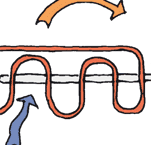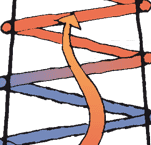Energy
Designing homes to conserve energy and use it efficiently, from sources that cause least environmental harm.
Continuous flow systems
Continuous flow systems provide an endless supply of hot water, so long as the electricity or gas is available.
On this page:
- Where continuous flow hot water systems are used
- How they operate
- Advantages and disadvantages
- Calculating size
- Connecting with other water heating systems
- Installation requirements
Where continuous flow hot water systems are used
Instantaneous or continuous flow hot water systems are typically used:
- for outlets that are a long way from the main hot water storage system
- where hot water use is low and inconsistent, such as in a holiday home
- to boost hot water supply from systems that are not always able to meet demand (such as heat pump water heaters or solar water heating)
- to boost hot water supply from limited storage systems or to fittings having high hot water demand (e.g. showers).
It is common in larger houses to have two smaller capacity (say 21 or 24 litre) continuous flow water heaters as opposed to one large 32 litre unit. This is to minimise the time delay of the hot water moving from one side of a house to the other. In very large houses it is logical to have smaller units in the ensuites of remote bedrooms.
How they operate
Continuous flow systems can be heated using electricity, gas or LPG.
Although electric systems are more energy-efficient than gas systems, gas has a higher maximum heating capacity and is better able to impart sufficient heat to mains pressure water.
Advantages and disadvantages
Advantages of continuous flow systems over storage systems include:
- continuous hot water, i.e. supply does not run out
- no requirement to keep water hot when not being used, so no standing losses and no energy input to maintain the temperature of stored water
- no need for a cylinder, so useful where space is limited
- heat is to the required outlet temperature, without the need to heat it to 60ºC first
- easily adjustable temperature
- can be located close to the outlet
- gas units are usually fitted on an outside wall, saving interior space.
Disadvantages include:
- gas units produce greenhouse gas emissions and there is uncertainty around the long-term availability of gas
- limited water flow rates
- achievable flow rates are lower in colder areas
- electric systems may require heavy duty wiring
- electric systems cannot use off-peak electricity supply rates
Calculating size
Gas continuous flow water heaters are available with a range of different flow rates, typically around 16 to 27 litres of hot water per minute. Small systems may be unable to cope with several hot water taps being used at the same time. The more hot water taps and showerheads there are in a home, the higher the flow rate should be. System suppliers can give more details and advice.
Connecting with other water heating systems
Continuous flow water heaters can operate in conjunction with hot water storage systems, to take advantage of and overcome disadvantages of each system:
- Example 1: Use a small volume hot water storage cylinder for the general hot water supply and supplement with a continuous flow water heater from a cold water feed for outlets with high hot water demand such as shower and washing machine. Mix hot water at the outlet with the flow rate maximised from the continuous flow water heater and minimised from the hot water storage cylinder.
- Example 2: Use the continuous flow water heater as a booster system to a storage system with limited hot water capacity or intermittent energy supply (such as solar systems or heat pumps). Requires specific plumbing arrangement.
Installation requirements
LPG and reticulated gas water heating systems are generally installed on the building exterior as they require good ventilation for the exhaust gases. If the system is installed internally, the space must be well ventilated and exhaust gases flued to the outside.
Electrical heaters are compact and can be installed close to the hot water outlet, often with cabinetry.
Updated: 23 May 2023



